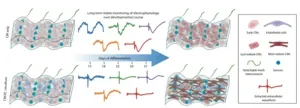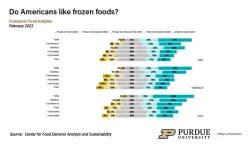(Press-News.org) SAN FRANCISCO, CA—March 8, 2023—When it comes to oxygen, you can have too much of a good thing. Breathing air that contains higher levels of oxygen than the usual 21 percent found in Earth’s atmosphere can cause organ damage, seizures, and even death in people and animals, particularly if it’s in excess of the body’s oxygen needs. Until now, however, scientists have mostly speculated about the mechanisms behind this phenomenon, known as oxygen toxicity, or hyperoxia.
Now, researchers at Gladstone Institutes have discovered how excess oxygen changes a handful of proteins in our cells that contain iron and sulfur—a chemical process similar to the rusting of iron. In turn, those “rusty” proteins trigger a cascade of events that damage cells and tissues. The findings, published in the journal Molecular Cell, have implications for conditions such as heart attacks and sleep apnea.
“This study allowed us to put together a very specific timeline for what happens in hyperoxia,” says Gladstone Assistant Investigator Isha Jain, PhD, senior author of the new study. “The results weren’t at all what we were expecting, but it’s very interesting and exciting to now know how this sequence of events unfolds.”
An Understudied Question
At high levels, oxygen is toxic to every form of life, from bacteria and plants to animals and people. Of course, not enough oxygen is also fatal; there’s an intermediate, “Goldilocks” amount under which most life on Earth thrives—not too much and not too little.
While clinicians have long studied the details of how oxygen shortage impacts cells and tissues (for example, in heart attacks and strokes), the effects of excess oxygen have been relatively understudied.
“For many years, the medical teaching was that, to a certain degree, more oxygen was better, or at least benign, when treating patients with conditions such as heart attacks,” says Alan Baik, MD, a postdoctoral scholar in Jain’s lab and a cardiologist at UC San Francisco (UCSF). “But there has now been a growing number of clinical studies showing that excess oxygen actually leads to worse outcomes. This motivated us to better understand why excess oxygen can be toxic.”
Studies have recently revealed, for instance, that breathing too much supplemental oxygen might be detrimental to heart attack patients and premature infants. Similarly, in obstructive sleep apnea, the sudden bursts of oxygen that follow pauses in breathing have been shown to be a key component of how the disorder increases patients’ risks of chronic health problems.
Still, the mechanisms of these effects remained murky. Many researchers assumed that reactive oxygen species—unstable and highly reactive oxygen derivatives that can damage our genome and many molecules in our cells—likely played a role in hyperoxia, but there was little evidence to demonstrate how excess oxygen affects specific enzymes and pathways.
How CRISPR Found the Answer
Jain’s group—including Baik, postdoctoral fellow Galih Haribowo, PhD, and graduate student Kirsten Xuewen Chen, who are co-first authors of the new paper—turned to the genome editing technology CRISPR to test the roles of a variety of genes in hyperoxia.
Using CRISPR, the researchers removed, one at a time, more than 20,000 different genes from human cells grown in the lab and then compared the growth of each group of cells at 21 percent oxygen and 50 percent oxygen.
“This kind of unbiased screen let us probe the contributions of thousands of different pathways in hyperoxia rather than just focusing on those we already suspected might be involved,” says Jain, who is also an assistant professor of biochemistry at UCSF. “It led us toward molecules that have never been uttered before in the same sentence as oxygen toxicity.”
Four molecular pathways stood out in the screen as being involved in the effects of hyperoxia. They related to diverse cellular functions including the repair of damaged DNA, the production of new DNA building blocks, and the generation of cellular energy.
Protein Clusters in Common
At first, the team couldn’t pinpoint what the four pathways had in common and why they were all impacted by high oxygen levels. It took some molecular sleuthing to discover that each pathway had a critical protein that contained iron atoms connected to sulfur atoms—so-called “iron-sulfur clusters”—in its molecular structure.
The researchers went on to show that, in as little as 30 percent oxygen, the iron-sulfur clusters in the four proteins become oxidized—they chemically react with oxygen atoms—and that change causes the proteins to degrade. As a result, cells stop functioning correctly and consume even less oxygen, causing a further increase in oxygen levels in the surrounding tissues.
“One important takeaway is that hyperoxia is not impacting cells and tissues solely through reactive oxygen species, as many had assumed,” says Jain. “That means the use of antioxidants—which can combat reactive oxygen species to some degree—is unlikely to be sufficient to prevent oxygen toxicity.”
###
About the Study
The paper “Oxygen Toxicity Causes Cyclic Damage by Destabilizing Specific Fe-S Cluster-Containing Protein Complexes” was published in the journal Molecular Cell on March 8, 2023.
Other authors are: Bruno Queliconi, Alec Barrios, and Ankur Garg of Gladstone; Mazharul Maishan and Michael Matthay of UCSF; and Alexandre Campos of Sanford Burnham Prebys Medical Discovery Institute.
The work was supported by the National Institutes of Health (T32 HL007731, DP5OD026398), a Chan-Zuckerberg Biohub Physician-Scientist Fellowship, a Sarnoff Scholar Award, and the Sandler Program for Breakthrough Biomedical Research at UCSF.
About Gladstone Institutes
Gladstone Institutes is an independent, nonprofit life science research organization that uses visionary science and technology to overcome disease. Established in 1979, it is located in the epicenter of biomedical and technological innovation, in the Mission Bay neighborhood of San Francisco. Gladstone has created a research model that disrupts how science is done, funds big ideas, and attracts the brightest minds.
END
Excessive iron absorption by tumor cells in the digestive tract is known to play a major role in driving colorectal cancer – the third most prevalent and third leading cause of cancer deaths in the U.S.
In a new study published in the journal Advanced Science, University of New Mexico researchers describe the part played by the transferrin receptor (TFRC) gene in the growth of colorectal cancer tumors.
Iron is absorbed into intestinal cells both from the bloodstream and from iron-rich foods, such as red meat, said Xiang Xue, PhD, assistant professor ...
While the crowds swarm around Old Faithful to wait for its next eruption, a little pool just north of Yellowstone National Park’s most famous geyser is quietly showing off its own unique activity, also at more-or-less regular showtimes. Instead of erupting in a towering geyser, though, Doublet Pool cranks up the bass every 20 to 30 minutes by thumping. The water vibrates and the ground shakes.
Doublet Pool’s regular thumping is more than just an interesting tourist attraction. A new study led by University of Utah researchers shows that the ...
WEST LAFAYETTE, Ind. — Americans likely are receiving smaller tax refunds than they have in recent years, and most people will not be going out to spend this money, according to the February 2023 Consumer Food Insights Report. This month’s report also looks more closely at religious demographics and includes new data on frozen food preferences.
The survey-based report out of Purdue University’s Center for Food Demand Analysis and Sustainability assesses food spending, ...
A global dataset of ocean plastic pollution between 1979 and 2019 reveals a rapid and unprecedented increase in ocean plastics since 2005, according to a study published March 8, 2023 in the open-access journal PLOS ONE by Marcus Eriksen from The 5 Gyres Institute, USA, and colleagues.
Understanding plastic accumulation in the oceans to date could provide a critical baseline to help address this form of pollution. Previous studies have focused primarily on northern-hemisphere oceans near the world’s most industrialized nations, ...
A new analysis of crime statistics near hundreds of places of worship in Washington, D.C., shows that these sites are associated with higher levels of violent and property crime—even after accounting for other factors commonly linked with crime. James Wo of the University of Iowa, U.S., presents these findings in the open-access journal PLOS ONE on March 8, 2023.
Prior research has established that places of worship foster social ties and community actions for the common good, suggesting that these sites would reduce crime in their neighborhoods. However, few studies have addressed the hypothesized ...
For educational attainment, it's more helpful to grow up in an affluent neighborhood than it is harmful to grow up in a poor one, per 23-year large Netherlands cohort study
###
Article URL: https://journals.plos.org/plosone/article?id=10.1371/journal.pone.0281928
Article Title: Neighbourhood effects on educational attainment. What matters more: Exposure to poverty or exposure to affluence?
Author Countries: The Netherlands, UK
Funding: The research leading to these results has received funding from the European Research Council (https://erc.europa.eu/) ...
After 6 months of disrupted schooling during COVID-19, German students scored substantially lower on intelligence tests than comparative earlier cohorts, with the gap persisting after 16 months
###
Article URL: https://journals.plos.org/plosone/article?id=10.1371/journal.pone.0281779
Article Title: Students’ intelligence test results after six and sixteen months of irregular schooling due to the COVID-19 pandemic
Author Countries: Germany
Funding: The study was supported by a grant awarded to M.B. by the Research Fund of ...
Participants in psychology studies are more likely than average to exhibit symptoms of personality disorders, potentially skewing the findings of such research
###
Article URL: https://journals.plos.org/plosone/article?id=10.1371/journal.pone.0281046
Article Title: Self-selection biases in psychological studies: Personality and affective disorders are prevalent among participants
Author Countries: Poland, Spain, Italy
Funding: To conduct Face-to-Face Studies IK was supported by grants 2017/01/X/HS6/02022 from the National Center of Science ...
New study finds obstacles can trap rolling microparticles in fluid
Through simulations and experiments, physicists attribute the trapping effect to stagnant pockets of fluid, created by hydrodynamics
Random motions of the molecules within the fluid then ‘kick’ the microroller into a stagnant pocket, effectively trapping it
Size of the obstacle also controls how easy it is to trap a microroller and how long it remains trapped
EVANSTON, Ill. — When physicists steered a tiny microparticle toward a cylindrical obstacle, they expected one of two outcomes to occur. The particle would either collide into the ...
Scientists from the Trinity Biomedical Sciences Institute (TBSI) have shed new light on ageing processes in the brain. By linking the increased presence of specialised immune cells to conditions such as Alzheimer’s disease and traumatic brain injury for the first time, they have unearthed a possible new target for therapies aimed at treating age-related neurological diseases.
The research, which benefited from a collaboration with experts at the University of Maryland School of Medicine and focused ...










